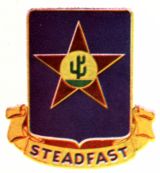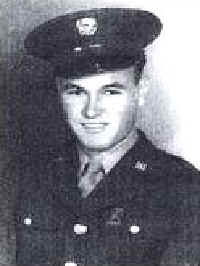- DON
VOLUNTERRED FOR THE ARMY IN NOV. 1942.
HE JOINED THE ENLISTED RESERVE
- CORPS
AS PART OF THE ARMY SPECIALIZED TRAINING PROGRAM (ASTP) TO GUARANTEE
- COMPLETION
OF HIS SOPHOMORE YEAR OF COLLEGE. HE WAS IN PRE-ENGINEERING
- STUDIES AT
TEXAS A&I IN KINGSVILLE, TX.
- HE TOOK HIS ASTP BASIC TRAINING AT CAMP MAXEY IN TEXAS.
AS PLANS FOR THE
- INVASION OF EUROPE WERE DEVELOPED, THE ASTP PROGRAM WAS DISBANDED.
- IN OTHER WORDS, UNCLE SAM NEEDED INFANTRY. THE ENTIRE TEXAS A&I, ASTP
- STUDENT BODY REPORTED TO CAMP HOWZE, TEXAS IN THE SPRING OF 1944.
DON WAS
- ASSIGNED TO COMPANY D, 409TH INFANTRY REGIMENT, 103RD
DIVISION, A HEAVY
- MACHINE GUN UNIT. DON
WAS THE 1ST GUNNER IN THE 1st PLATOON, 1st
SECTION.
- HIS SQUAD LEADER WAS
SGT ARLIE GRAY, HIS SECTION LEADER WAS S/SGT LOUIE
- MICHALSKI AND HIS PLATOON SGT WAS T/SGT CHUCK CERONSKY WHEN THEY
- ARRIVED IN MARSEILLE, FRANCE ON OCTOBER 20, 1944 VIA THE USS
MONTICELLO.
- HE SERVED IN RHINELAND AND ALSACE BEFORE HE WAS WOUNDED AND CAPTURED
- AT SELESTAT, FRANCE ON 12/02/44. DON
SPENT THE REMAINDER OF THE WAR AS A POW
- IN CZECHOSLOVAKIA.
- (In the words of Don McGregor)
|
- The 1st
Casualty
-
- At the staging area outside Marseille, near Calas, there were
numerous poles about 90 feet tall that had been
- installed to thwart German intelligence efforts in some way.
The poles were not placed very deeply in the ground
- and were secured by guy wires on four sides.
-
- We set up our tents in accepted military fashion, row on row.
In the next row over from mine, a couple of men
- found that a guy wire was in their way, so they cut it.
During the night, I heard a loud boom and the ground shook.
- I thought the Germans had broken through and we were being attacked.
-
- I crawled out of my tent and found that the pole had fallen across
the tent next to mine. When
the pole hit the
- ground, it broke a leg of one soldier and killed another.
The pole also hit the box that was holding my machine
- gun and destroyed it.
-
- Not only had I witnessed my first American casualty, I was about to
go to war without a weapon.
-
- Don’s remembrance of
Selestat.
-
- The 409th
approached Selestat from the northwest on December 1st,
1944. 1st
Battalion
- (Companies
A, B, C & D) stopped beyond the Giessen River Bridge leading into
Selestat. We were told we
- would stay
there to prevent any German units from coming out in our direction.
The schedule was to wait until
- the next
day, Dec. 2, and three divisions would attack Selestat. They were the 103rd, 36th, and the 14th armored.
- I was secure in my own
little foxhole beneath the pavement in the road leading into Selestat.
-
- All of a
sudden we heard rifle fire and bazooka ammo going off. A rifle
company, Co. B, didn't wait until the next
- day.
They were ordered to enter Selestat on the night of Dec. 1st
to take some houses on the outskirts.
That was contrary to the orders we’d been given.
-
- Capt.
Dempsey’s Company B, Rifle Company, took six houses. About 9 o'clock, we were ordered to join the
- rifle
company. Our Platoon
Leader, Lt. Louis Daloisio, insisted on it.
We were about half way across the bridge
- when our
section Sgt (Michalski) showed up. "Where in the Hell are you
going," he demanded. We were blessed
- by having
some pretty good sergeants leading us. He told us to get back in the
foxholes where we belonged.
- Here came
Daloisio, "Where are you going?"
We replied, "We are going back to the foxholes."
The Lt. said,
- "Get
into those houses." Michalski
objected to this order but, as all good soldiers do, bowed to the
Lt’s rank
- and
followed the order.
-
- 1st Lt.
Withum was our D Company Commander, though he played no part in this.
- My
D-Company - 1st platoon had to tag along with company B. (The machine
gun platoons were at the mercy of
- the rifle
company commanders. We attached to them.) So much for feeling secure
in my foxhole!
-
- The rifle
company used up their entire bazooka (anti tank) ammo taking the
houses. They had found
that bazooka
- ammo was
as good for taking houses as it was for tanks.
-
- I was in
the first house on the right hand side. We wouldn’t have any tanks
until the next morning. We
were all
- right for
six hours. Then we heard
some tanks fire up. We
didn't have any bazooka ammo. We
were
- defenseless
against tanks. The tanks
came down the street and parked in front of the houses.
The first thing the
- lead tank
did was blow up the bridge. We were trapped!
-
- After they
blew up the bridge, they turned their .88 millimeter guns to the
houses. They were sitting
point-blank
- at
curbside and we were ‘sitting ducks’.
I thought I had drawn my last breath.
The tanks were supporting
- 600 to 800
German infantry. Therefore,
the tanks first targets were the Heavy Machine Guns. .OURS!
-
- The first
shot from the tanks blew apart my machine gun. The second shot blew a hole in the back of the house.
- Then the
tanks blew some timbers from the roof.
I was dazed and wounded by shrapnel.
After I came to, I
- looked for
a way to get out of the house. I
noticed the hole in the back wall toward the river. Four others of my
- squad
jumped out the hole and made it to the river. I
jumped out the hole and was intending to run for the river,
- but I was
too late. German infantry
were already standing there with automatic weapons. Being a 1st
gunner, I
- carried
only a .45 pistol. Though it seemed like an eternity, the one-sided
battle couldn’t have lasted more than
- a few
minutes. Just like that,
I was a POW!
-
- As a result of that night's action, Co. B counted 98 missing in
action, 1 killed in action, and 2 wounded in action.
- Co. D bore the brunt. We
counted 18 missing in action, 9 wounded in action and 3 killed in
action.
-
- My combat
days were over, but the fight for survival was to become more intense!
-
- POW
-
- We were herded across the Rhine and forced to dig trench
emplacements for the defense of a German position.
- This, of course, was contrary to the Geneva Convention, but we were
in no position to protest. Eventually,
we
- were placed in box cars and made a long trip to a POW camp in
Limburg, Germany (Stalag XIIA). Our
diet
- consisted of what we called grass soup.
The rumor was that when we got to a permanent camp, the diet
would
- improve. That never
happened.
-
- Our next train ride placed us in a camp near Muhlberg (Stalag IV-B)
for Christmas. On January
2, 1945,
- I arrived at my new home. We
arrived at Kamnitz, Czechoslovakia in the Sudeten Mountains.
- (After the Germans were defeated, the Czech’s changed the name
from Kamnitz to Ceska Kamenice) By this time,
- there was only Ted Jenkins left with me from my outfit.
They’d managed to scatter us out pretty good.
At this
- location, we were stripped of our olive drab clothing.
Our winter protective clothing was replaced with clothing
- that was inadequate, to say the least, for winters in the mountains.
Many of us suffered from frostbite.
-
- We were placed in work crews and were forced to dig tunnels in the
mountainside. They were
attempting to
- construct an underground aircraft factory that would be impervious
to allied bombing.
- Six days a week (Sundays off), we were marched to our work site
several miles away. We
worked 8 to 10
- hours and then marched back to the camp, arriving about dark.
We never received lunch and received only a
- piece of bread and some kohlrabi (a sort of cabbage) soup for our
efforts.
-
- Finally, on May 8th, our German guards opened the camp
gates and told us we were free to go.
There were
- no American liberators in site. We were told that we were on our own to get back to our
lines, or we could
- wait and be liberated by the Russians. No Thanks! By
this time, we were all weakened by the hard labor and
- sparse nourishment. I
had gone from 130 pounds to under 100.
However, we left the camp on May 9th and
- spent the next 9 days getting back into American hands.
We would have never made it had it not been for the
German/Czech civilians who would come out of their houses to feed us.
Of the 200 of us that originally arrived
- at the camp, only 175 survived.
-
|


